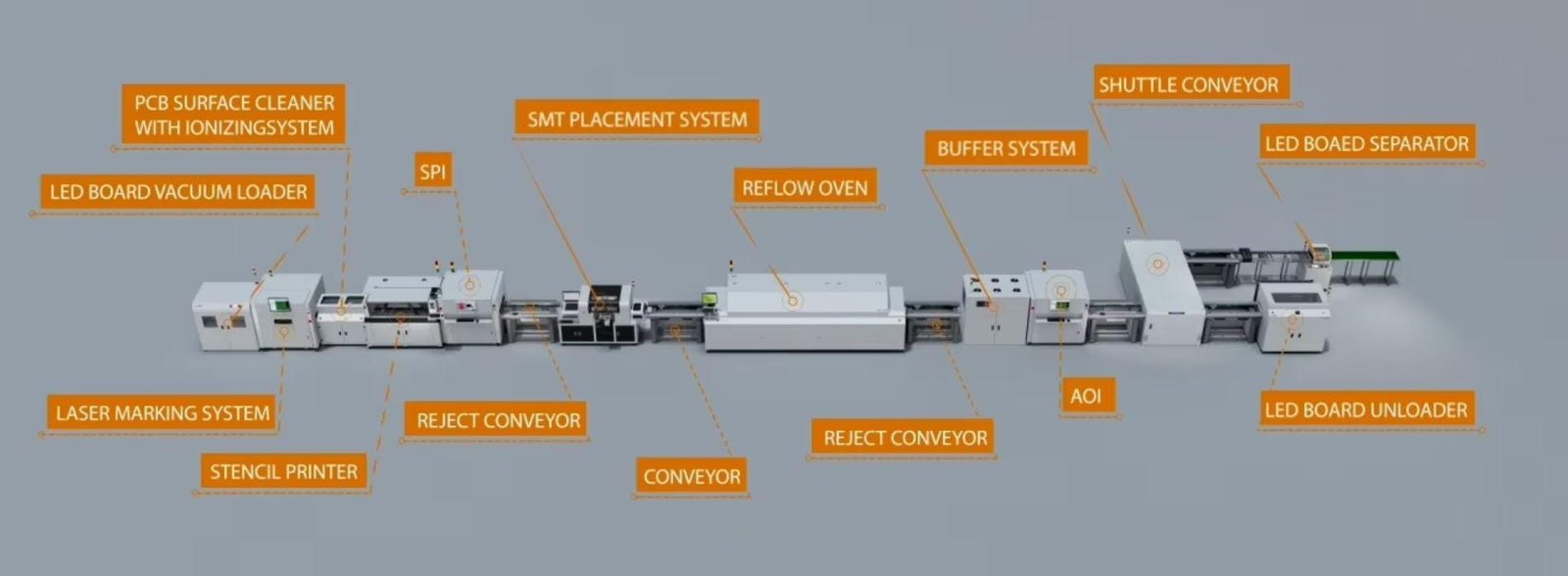
Equipos principales en la producción SMT
Las líneas de producción SMT incluyen diversos equipos esenciales utilizados en la industria de fabricación electrónica. Entre los dispositivos clave se incluyen máquinas de selección y colocación, impresoras de pasta de soldadura, SPI, hornos de reflujo, AOI, cargadores de placas y sistemas de transporte. Cada tipo de equipo tiene funciones y propósitos específicos, que analizaremos a continuación.
1. Máquina de selección y colocación SMT
Las máquinas de selección y colocación SMT se clasifican en máquinas de torreta, de pórtico y modulares. Estas máquinas son fundamentales en la tecnología de producción SMT y se utilizan principalmente para colocar componentes electrónicos con precisión y rapidez en las posiciones designadas de la placa de circuito impreso (PCB) mediante métodos específicos.
2. Impresora de pasta de soldadura SMT
Existen tres tipos de impresoras de pasta de soldadura: manuales, semiautomáticas y totalmente automáticas. La impresora de pasta de soldadura es el punto de partida de la línea de producción SMT y desempeña un papel crucial en la calidad y eficiencia del preensamblaje de los productos electrónicos SMT. Aplica la pasta de soldadura uniformemente sobre los pads correspondientes de la PCB mediante una plantilla, similar al proceso de impresión utilizado en las escuelas para imprimir hojas de prueba. Ante el aumento de la demanda de ensamblaje de productos electrónicos, la mayoría de las empresas han adoptado impresoras de pasta de soldadura totalmente automáticas. Estas no solo mejoran la calidad del producto y aumentan la eficiencia de la producción, sino que también ahorran costos de mano de obra, lo que aumenta la eficiencia del proceso.
3. Equipo de inspección SPI
La SPI se coloca generalmente justo después de la impresora de pasta de soldadura SMT. Una vez impresa la PCB con pasta de soldadura, se transporta mediante un sistema transportador a la SPI para su inspección. Este proceso mejora eficazmente el rendimiento de los productos SMT al filtrar las PCB defectuosas con una aplicación deficiente de la pasta de soldadura. Permite rastrear las causas raíz de los defectos, abordando así los problemas principales y controlando los costos de mantenimiento futuros, lo que en última instancia contribuye a aumentar la capacidad de producción y la rentabilidad.
4. Soldadura por reflujo SMT
La soldadura por reflujo es un proceso crucial que garantiza la calidad de los productos electrónicos de montaje superficial. Este método utiliza calentamiento por convección para calentar continuamente las PCB sin soldar, lo que provoca que el material de soldadura se funda y enfríe, solidificando los componentes sobre las almohadillas de la PCB.
5. Equipo AOI
El equipo AOI (Inspección Óptica Automatizada) se ubica generalmente al final de la línea de producción SMT, después del proceso de soldadura por reflujo. Emplea principios ópticos para detectar automáticamente defectos comunes durante el proceso de soldadura. La AOI es una tecnología de prueba en rápida expansión, y muchos fabricantes están introduciendo sus propios equipos de inspección AOI. Durante la detección automática, la máquina escanea la PCB mediante cámaras, captura imágenes y compara las uniones de soldadura probadas con los parámetros válidos en una base de datos. Tras el procesamiento de las imágenes, identifica los defectos en la PCB, mostrándolos o marcándolos para que los técnicos los rectifiquen.
